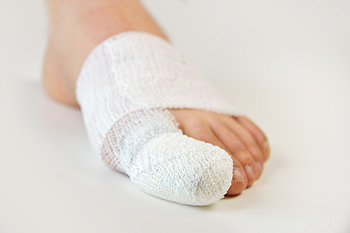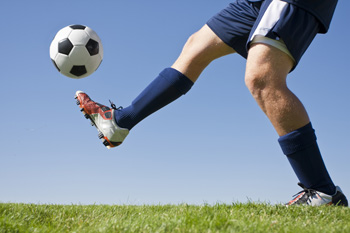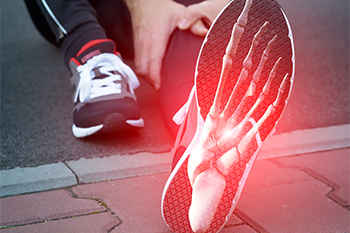Items filtered by date: July 2022
Why Live with Pain and Numbness in Your Feet?
Four Categories of Broken Toes

The bones in the toes are known as phalanges, and the big toe consists of two phalanges. There are four types of broken toes that can occur, compressed, comminuted, displaced and non-displaced. In a comminuted fracture, the bone can break into several fragments. When force presses the ends of the bones towards the center, a compressed fracture has occurred. A bone that is moved out of its normal position is indicative of a displaced fracture, while a broken bone that stays in position is called a non-displaced fracture. The most common toe to break is the pinky toe, and this is often done by jamming it into a piece of furniture, or if something heavy drops on it. If the break is mild, buddy taping may be an effective way to promote stability to the toe as the healing process begins. This is done by taping the affected toe to the toe next to it, which may help keep it straight. If you suspect you have broken your toe, a podiatrist can provide an X-ray that can determine the extent of the fracture, and offer you correct treatment options.
Broken toes may cause a lot of pain and should be treated as soon as possible. If you have any concerns about your feet, contact Dr. Richard T. Bauer from Summit Foot & Ankle. Our doctor will treat your foot and ankle needs.
What Is a Broken Toe?
A broken toe occurs when one or more of the toe bones of the foot are broken after an injury. Injuries such as stubbing your toe or dropping a heavy object on it may cause a toe fracture.
Symptoms of a Broken Toe
- Swelling
- Pain (with/without wearing shoes)
- Stiffness
- Nail Injury
Although the injured toe should be monitored daily, it is especially important to have a podiatrist look at your toe if you have severe symptoms. Some of these symptoms include worsening or new pain that is not relieved with medication, sores, redness, or open wounds near the toe.
If you have any questions, please feel free to contact our office located in Latham, NY . We offer the newest diagnostic and treatment technologies for all your foot care needs.
Common Soccer Injuries of the Feet, Ankle, and Lower Leg

Soccer players can sustain foot, ankle, and lower leg injuries that are either traumatic (collisions, knocks, falls, etc.) or due to repetitive strains on tissues, joints, and muscles. A common traumatic injury in soccer is an ankle sprain—where the ligament(s) in the ankle stretch excessively or tear. An Achilles tendon rupture is another acute injury where this tendon—which attaches the calf muscles to the heel—partially or fully tears. Also, when running or jumping, a soccer player’s lower leg muscle can sometimes pull away from the Achilles tendon. Examples of overuse injuries include plantar fasciitis, which is an inflammatory condition causing heel pain, Achilles tendonitis, and stress fractures—which are very common in soccer players. Warming up properly, wearing protective gear, healing properly even after a minor injury, training appropriately, and staying off of wet playing fields are all good ways to help avoid a soccer injury. See a podiatrist to receive treatment for these or any other soccer injury, and to learn more about how to prevent future injuries.
Ankle and foot injuries are common among athletes and in many sports. They can be caused by several problems and may be potentially serious. If you are feeling pain or think you were injured in a sporting event or when exercising, consult with Dr. Richard T. Bauer from Summit Foot & Ankle. Our doctor will assess your condition and provide you with quality foot and ankle treatment.
Common Injuries
The most common injuries that occur in sporting activities include:
- Achilles Tendonitis
- Achilles Tendon Rupture
- Ankle Sprains
- Broken Foot
- Plantar Fasciitis
- Stress Fractures
- Turf Toe
Symptoms
Symptoms vary depending upon the injury and in some cases, there may be no symptoms at all. However, in most cases, some form of symptom is experienced. Pain, aching, burning, bruising, tenderness, tightness or stiffness, sensation loss, difficulty moving, and swelling are the most common symptoms.
Treatment
Just as symptoms vary depending upon the injury, so do treatment options. A common treatment method is known as the RICE method. This method involves rest, applying ice, compression and elevating the afflicted foot or ankle. If the injury appears to be more serious, surgery might be required, such as arthroscopic or reconstructive surgery. Lastly, rehabilitation or therapy might be needed to gain full functionality in the afflicted area. Any discomfort experienced by an athlete must be evaluated by a licensed, reputable medical professional.
If you have any questions, please feel free to contact our office located in Latham, NY . We offer the newest diagnostic and treatment technologies for all your foot care needs.
The Relationship Between Running and Swollen Feet
 Swollen feet is undoubtedly an uncomfortable and unpleasant condition that can affect many people. While pregnant women and those who suffer from diabetes are famously prone to suffering from swollen feet, runners may experience this condition. Runners’ feet may swell both during and after runs for a number of reasons. First, tight and restrictive running shoes can contribute to swelling. Since ill-fitting shoes often squeeze the toes and heels, muscles in the feet become overwhelmed in trying to maintain balance while running, resulting in swelling. Be sure to select the right pair of comfortable running shoes that match your foot type to avoid this pitfall. Additionally, runners’ feet may swell up if they are simply running with poor technique. For example, if a runner lands on their heels instead of the balls of their feet during their runs, they can essentially place more pressure on the bottoms of their feet, which can lead to foot swelling. If you find yourself suffering from swollen feet after runs, you might try applying ice to your feet to reduce the swelling or even elevating your feet. A podiatrist may be able to help you manage this condition and help you mitigate its effects.
Swollen feet is undoubtedly an uncomfortable and unpleasant condition that can affect many people. While pregnant women and those who suffer from diabetes are famously prone to suffering from swollen feet, runners may experience this condition. Runners’ feet may swell both during and after runs for a number of reasons. First, tight and restrictive running shoes can contribute to swelling. Since ill-fitting shoes often squeeze the toes and heels, muscles in the feet become overwhelmed in trying to maintain balance while running, resulting in swelling. Be sure to select the right pair of comfortable running shoes that match your foot type to avoid this pitfall. Additionally, runners’ feet may swell up if they are simply running with poor technique. For example, if a runner lands on their heels instead of the balls of their feet during their runs, they can essentially place more pressure on the bottoms of their feet, which can lead to foot swelling. If you find yourself suffering from swollen feet after runs, you might try applying ice to your feet to reduce the swelling or even elevating your feet. A podiatrist may be able to help you manage this condition and help you mitigate its effects.
Swollen feet can be a sign of an underlying condition. If you have any concerns, contact Dr. Richard T. Bauer of Summit Foot & Ankle. Our doctor can provide the care you need to keep you pain-free and on your feet.
Swollen feet are a common ailment among pregnant women and people who stand or sit for extended periods. Aging may increase the possibility of swollen feet and patients who are obese often notice when their feet are swelling too. There may be medical reasons why swollen feet occur:
- Phlebitis - A condition that causes the veins to become inflamed and can also cause leg pain.
- Liver disease - This may lead to low blood levels of albumin which is a protein. This can cause fluid in the blood to pass into the tissues and several areas of the body can become swollen.
- Heart failure - When the heart doesn’t pump properly the blood that is normally pumped back to the heart can pool in the veins of the legs causing swollen feet.
- Kidney disease - One of the main functions of the kidneys is releasing excess fluid in the body. This type of condition can make it difficult for the kidneys to function properly, and as a result the feet may become swollen.
- Deep-vein thrombosis (DVT)- This is a serious condition where blood clots form in the veins of the legs. They can block the return of blood from the legs to the heart which may cause the feet to swell. It is important to be treated by a podiatrist if this condition is present.
Swollen feet can also be caused by bone and tendon conditions, including fractures, arthritis, and tendinitis. Additionally, there may be skin and toenail conditions and an infection may cause the feet to swell. Patients who take medicine to treat high blood pressure may be prone to getting swollen feet.
Many patients elevate their feet to help relieve the swelling and this is generally a temporary remedy. When a podiatrist is consulted the reason behind the swelling can be uncovered and subsequently treated.
If you have any questions please feel free to contact our office located in Latham, NY . We offer the newest diagnostic tools and technology to treat your foot and ankle needs.
What You Might Look For in a Running Shoe

Running is a cherished pastime across the country and an excellent way to stay in shape. However, if you are running with ill-fitting running shoes, you could be putting the health of your feet in jeopardy. Running with shoes that do not match the shape of your foot can lead to afflictions including bunions and naked toes. To avoid these unpleasant conditions, you should be mindful of what you might look for in a potential pair of running shoes. Of course, selecting the ideal pair of shoes is a highly individual process that will be specific to each runner. Yet, there are rules that runners might follow to guide them along this process. First and foremost, runners should prioritize finding shoes that fit the shape of their feet instead of shoes that look most fashionable or visually appealing. Additionally, a good pair of running shoes will have an insole that mirrors the natural shape of the runner's arch. Ideally, the ankle collar of the running shoe will fit comfortably and securely, but not tightly enough to cause rubbing and chafing. Good running shoes will also have toe boxes that give each toe enough space to comfortably rest in the shoe. When it comes to running, selecting the right running shoe is no joke, but these guidelines and a podiatrist might help you in your search.
If you are a runner, wearing the right running shoe is essential. For more information, contact Dr. Richard T. Bauer from Summit Foot & Ankle. Our doctor can provide the care you need to keep you pain-free and on your feet.
Choosing the Right Running Shoe for Your Foot Type
To increase performance and avoid the risk of injury, it is important to choose the right running shoe based on your foot type. The general design of running shoes revolves around pronation, which is how the ankle rolls from outside to inside when the foot strikes the ground.
- Neutral runners are able to choose from a wide variety of shoes, including minimalist shoes or even going barefoot.
- Runners who overpronate, or experience an over-abundance of ankle rolling, should choose shoes that provide extra motion control and stability.
- Runners who underpronate, or supinate, have feet that have high arches and lack flexibility, preventing shock absorption. They require shoes with more flexibility and cushion.
If you have any questions please feel free to contact our office located in Latham, NY . We offer the newest diagnostic and treatment technologies for all your foot and ankle needs.

